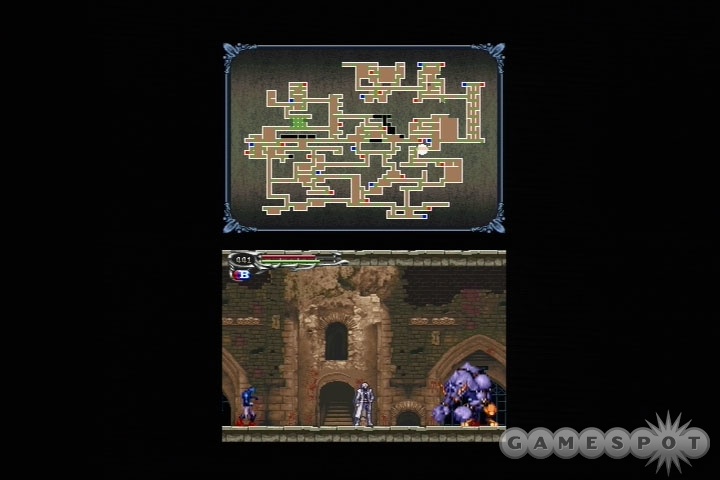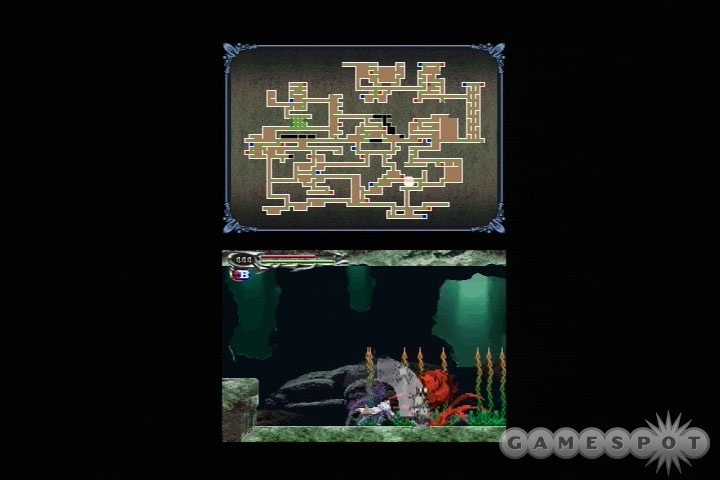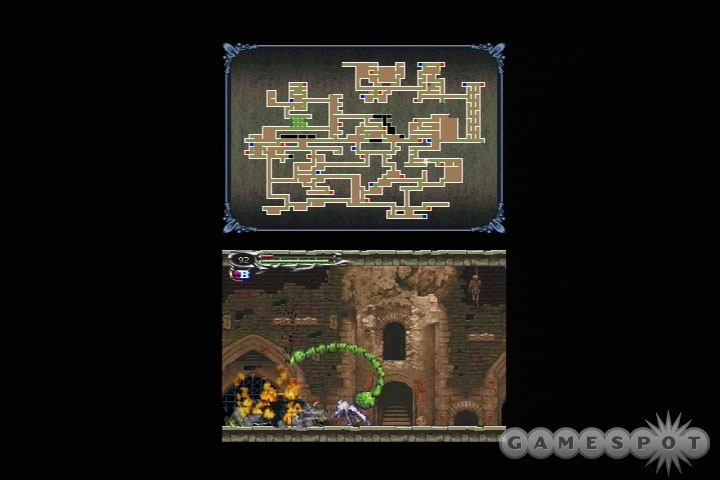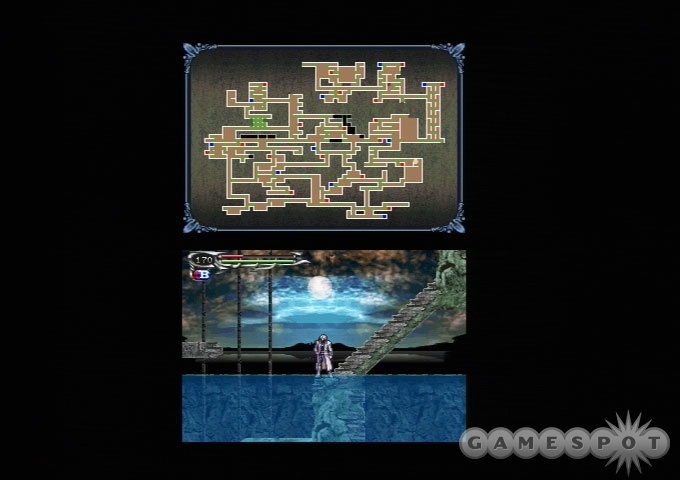Castlevania: Dawn of Sorrow is the latest iteration of Konami's decades-old franchise and the first to appear on the Nintendo DS. Don't let the title fool you; this really isn't the dawn of anything, except maybe a bunch more Castlevania games on the DS. And the subtitle here is simply a workable way to include the letters D and S in the title of the game, as seems to be the requirement for the platform at this point. Dawn of Sorrow actually takes place a year after the events in Aria of Sorrow, which came out in 2003 on the Game Boy Advance. If you've played that game--or if you've played just about any recent Castlevania game actually--you'll be right at home with Dawn of Sorrow, because it's basically the same game repackaged to fit the DS. That isn't a bad thing though, because the Castlevania games have long carried the torch for good, old-fashioned 2D side-scrolling gameplay, and Dawn of Sorrow keeps that flame burning as bright as ever.

The star of Dawn of Sorrow is Soma Cruz, the young adventurer who narrowly avoided becoming the next Dracula in Aria of Sorrow. Soma has the ability to collect the souls of monsters he kills, thus inheriting their powers. A year after Soma escaped Dracula's castle, a mysterious woman named Celia shows up and attacks him. Celia is a priestess of a new cult that is attempting to resurrect Dracula. Since Soma already proved once before that he's capable of foiling the resurrection of the dark lord, the cult decides to eliminate him before he can mess up their plans as well. Soma survives the attack quite easily and Celia is forced to retreat. Apparently Soma doesn't take kindly to people who try to kill him, so he sets out to find Celia and prevent her from reviving Dracula.
The entire game takes place at the cult's base, which is a replica of Dracula's castle. In true Castlevania form you'll start off relatively weak, with only a knife and some mediocre armor. As you progress through areas of the castle, you'll fight monsters and search the mazelike hallways where you'll gain experience, as well as find new and better equipment. As you gain experience, you'll level up and your stats will increase in attack, defense, strength, constitution, intelligence, and luck.
Throughout the game you'll also collect the souls of monsters you kill. These souls can be equipped to give Soma new abilities. There are three types of souls you can equip, as well as ability-type souls that grant you special powers without having to equip them. Ability souls are collected when you defeat bosses, and these abilities are usually required to progress through the game. By using these ability souls Soma can learn how to double-jump, move underwater, and break crystal blocks--all of which are required to access certain areas of the castle.
The other three types of souls have to be equipped. Bullet-type souls give you a special attack, usually involving projectiles of some sort. If you have the axe armor soul equipped, you can throw axes at your foes. However, each toss of the axe consumes a little magic. Guardian souls have a wide range of effects, and when activated they continuously consume your magic points. These souls let you summon familiars and perform special abilities, like turning into a bat. Finally, there are enchant-type souls, which have to be equipped but don't cost any magic points. These souls grant passive stat or ability bonuses. For example, you can equip the golem soul to get a bonus to your strength, or the skelerang soul to improve your throwing ability. Since there are more than 100 different enemies in the game, the combinations are almost endless. Not all monsters give up their souls that easily, though. You'll usually have to defeat the same monster several times in order to collect its soul, and since some monsters appear very rarely, it can take quite awhile to collect every type of soul in the game.

The souls also play a role in customizing your equipment. As you play you'll collect all kinds of weapons, armor, and accessories. Soma is skilled with a variety of monster-killing implements like swords, spears, axes, and guns. Each weapon can be fused with a soul to create a new, more powerful weapon. Once you fuse a soul with a weapon, you can no longer use that soul unless you release it from the weapon. The fused weapons are much stronger than the regular weapons you find, which gives you all the more reason to keep collecting souls. Once you have your weapons and gear in order, you can set up two different equipment and soul configurations to meet specific needs. While playing, you can simply hit the X button to quickly switch between the two configurations. This doesn't quite eliminate the need for you to access your equipment menu altogether, but it does help keep the breaks in the action to a minimum.
The castle is split up into several interconnected areas, each with a different theme. You'll explore a clock tower, a garden, a chapel, an underground cavern, and more. If you've played previous Castlevania games, you won't find many surprises in the level design here. The game is fairly linear, since certain abilities are required to access certain areas. But there's no handholding going on here. You'll have to figure out the path for yourself, and other than the frequent dead ends, there are no clues to point you in the right direction. You'll rely on the map (conveniently displayed on the top screen) to tell you where you need to go, but even with that you'll spend a lot of time aimlessly roaming the halls trying to figure out where to go to move the game along. The enemies reappear every time you enter a room, so even when you're just wandering around, you still have plenty of monsters to keep you busy. You'll grow stronger as you continue to defeat the monsters.
So far all that stuff is pretty much the same as the previous 2D Castlevania game, so you might be wondering what makes Dawn of Sorrow different. For one thing, the game does use the touch-screen functionality of the Nintendo DS, although it feels rather ancillary in practice. You can touch the screen to break crystal blocks, but those only appear in a few rooms and they don't really mesh with the rest of the castle. You can also use the touch screen to command certain familiars to attack monsters. This isn't worth the trouble, though, since you can't attack with Soma while guiding a familiar on the touch screen.

The most important use of the touch screen is tracing magic symbols. Throughout the game you'll collect magic symbols that will let you open certain sealed doors and finish off boss monsters. When fighting one of the many bosses, you'll eventually inflict enough damage to weaken that boss. When this happens, you have a few seconds to trace a magic symbol on the touch screen. If you're successful, the boss will die; but if you fail, the boss will regain some of its hit points and you'll have to repeat the process. Again, it's somewhat awkward to use the touch screen, because you have to quickly transition from the intense button-pressing of a boss battle to tracing lines on the touch screen. Unless you're playing with the stylus in your hand, you'll probably just have to use your finger, which isn't very precise. Fortunately, the game is fairly forgiving when it comes to tracing magic symbols, and as awkward as it may feel, you probably won't require more than one or two tries to successfully seal a boss. Though, that could be one try more than you can afford if it's an especially close battle.
The best part about Castlevania on the DS, as opposed to the Game Boy Advance, is the way the game looks and sounds. The backgrounds are intricate and gorgeous, with layer upon layer of fine detail and some interesting pseudo-3D effects. The character sprites range in size from tiny to massive, and some creatures fill the entire screen. There are more than 100 enemies in the game, and while many of them have been taken directly from the previous game, you'll see some new faces here as well. Even the enemies that you've seen before have been updated to look and behave much more lifelike. In fact, the character animation is one of the highlights here. It's quite funny to see a student witch cautiously take to the air on a broom, only to fall clumsily on her butt after a short flight; or to see a couple of skeletons throw food at you and then turn and run, only to hit a wall and fall to pieces. Although the character sprites still retain the faceless Konami look, they are quite detailed. For instance, when Soma is outside in a snowy village area, you can see his breath puff out into the cold air as he breathes. That detail extends to the environments as well. Some levels seem to go on forever into the distance, and others have cool effects, like giant mirrors that reflect the wall of the room that is normally transparent in a side-scrolling game. Small touches like these help maintain the illusion that a huge castle filled with a vast array of creatures has somehow been crammed onto Nintendo's handheld without sacrificing even the slightest detail.
The sound in Dawn of Sorrow is head and shoulders above its predecessor also. For one thing, the music sounds much clearer and more defined on the DS. Each different area has its own theme, and they are all somehow upbeat and creepy at the same time, which really keeps you moving along. Some of the tunes fade into the background, but there are several catchy gems on the soundtrack, like the almost funky gothic beats of the "wizardry lab" and "silenced ruins" themes. The sound effects are well done, although they do retain the same slightly digitized, distorted sound that has been with the series forever. Despite that, the whoosh of Soma's jump and the crash of a bursting candelabra sound just as you'd want them to.

Dawn of Sorrow is fairly easy as far as Castlevania games go, but the challenge here lies in collecting all the souls and opening up every nook and cranny in the castle rather than merely staying alive. You can beat the game in less than five hours if you know what you're doing, but you'll miss a whole lot of the game if you do that. And even after you beat the game you'll want to keep playing for the extras. When you beat the game you can play through again as Julius Belmont, and you can also unlock a boss rush mode, which allows you to fight all the bosses from the game in quick succession. There are multiple endings to the game too, which gives you even more incentive to strive for that 100 percent completion. There's an enemy set mode as well, where you're given a blank five-room level that you can populate with monsters you've collected. You can then run through the level to try to set the quickest time. If that isn't enough, you can also link up with a friend for wi-fi multiplayer. You can trade souls you've collected, or challenge your friend to make it through the custom level you've designed. So, although it's relatively short, there are plenty of reasons to keep coming back even after you've beat the game.
Castlevania: Dawn of Sorrow sticks close to the tried-and-true formula, so it will be an instant hit with anyone with an affinity for the sort of explorative gameplay the series is known for. While it doesn't do much to distinguish itself as the first Castlevania on the DS, the updated look, excellent music, and added controls help to refine the series even further. The bottom line is: Whether you're familiar with the series or not, you can't go wrong with Dawn of Sorrow.



